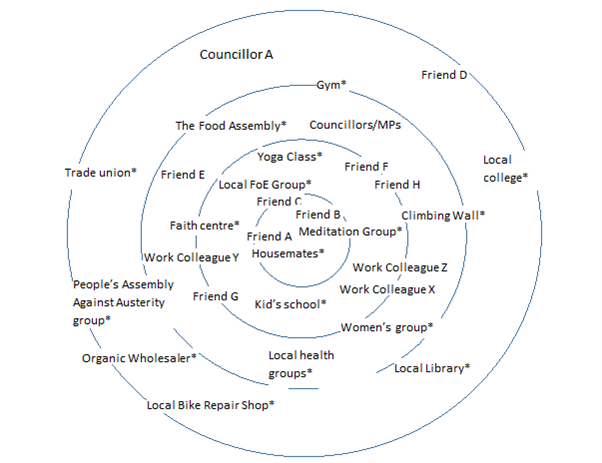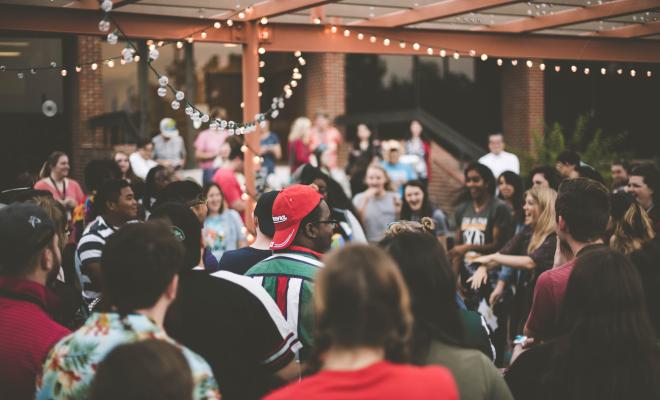03 Dec 2025
Friends of the Earth local action groups have achieved amazing things by working in strong alliances across their communities. We’ll need to continue to work collaboratively to achieve change at the scale we need to avert the climate and ecological crises.
Before we explore how to start building alliances, there are a few things to consider:
- Working in alliances takes time and a lot of work – it’s not just your own group's needs, aims and timeframes to consider. It can get complicated and sometimes challenging, but the rewards and the power we’ll build are totally worth it.
- Not all issues you work on will appeal to all groups. But the more we recognise the interconnectedness of struggles and acknowledge the systemic causes of so many of them, the more likely we are to find common ground and common solutions.
- Engage as many people as possible in the planning exercises that we’ll cover in this guide.
- The more knowledge and diversity of experiences that are in the room when doing the planning, the more likely that the outcomes will show breadth and depth across your community.
- How can you be a good ally to others? Do you have the capacity and resources to support other campaigns? Will you consider doing this even if it’s not obvious how your own campaign will benefit? We’ll discuss this more in the guide's later section on solidarity and meaningful allyship.
How to find allies
Building a network of groups you can work with requires you to have a good understanding of your local context, of what other change-makers are doing and of who is influencing who and how.
There are a number of mapping exercises that can help us work that all out: community mapping, movement mapping and influence mapping.
Community mapping
There are a few ways to do this, but a good starting point is to place people and groups on a map: draw 4 concentric circles and map people, institutions and groups you know on the circles. Those with a closer relationship to you go closer to the centre. It could look something like this:
Don’t just put down groups of people you know well. The idea is to include as many in your community as you can. Double check – have you included everyone?
Now you’re in a position to see all the potential allies in your community. Some may have more influence over decision-makers in your campaign, others may be in a good position to influence public opinion in your community, some may naturally align with what you’re trying to achieve.
While this exercise helps map who's in your community, it also helps to shed light on where there may be gaps in your understanding of the community, or in the support and services provided.
Community mapping won't just help you spot who you could work with, but also helps to identify some other useful things about your community that will help with your campaigning.
Movement mapping
As well as mapping the community more broadly, it’s important to understand who's working towards social change in your area. This is known as movement mapping, and it involves gaining a bit more info on local campaign groups as well as the work of voluntary and community sector organisations and groups. Below is an example of what a local movement map could look like, but you could also replicate the above circular map but with voluntary and community sector organisations, groups and campaigns specifically (note that the details below are made up!).
A movement map should help you understand who's working on what in your community, what tactics they use, who they’re trying to influence and how they organise. For organisations or groups that aren't campaigning, it'll also give you an opportunity to understand other work that's happening locally to try and bring about social change.
Crucially, a movement map can also show existing alliances in your community. Are there pre-existing networks you can work alongside? Is your local authority facilitating any strategic networks for voluntary groups? These networks are often key to understanding all the work that's happening locally. They're also important for connecting with organisations and groups that are working on issues related to environmental justice.
Community mapping and movement mapping can help you identify groups of people and potential allies to work with. But how do you prioritise who to reach out to? This is where an influencing map may come in useful.
Influence mapping
Think about the aims of your campaign. Now think about a group in your community.
- How aligned are they with your aims?
- How supportive are they likely to be?
- How much influence do they have locally?
- If your campaign involves influencing decision-makers, how much sway will they have with those decision-makers?
Now plot them on the graph below depending on how aligned and how influential they are.
- Most aligned and more influential
- Least aligned and least influential
- Least aligned but most influential
- Most aligned but least influential
It’s not an exact science and there’ll be nuances you won’t quite be able to capture – but this will help you to see roughly who will be most aligned and influential in your campaign. Start by reaching out to those who are most aligned to your aims and who will have the most influence.
Don’t forget about others on the map – how can you bring those who are less aligned, more in line with your aims? How can you help to increase the power and influence of those who are aligned but have little influence over your decision-maker?
Be conscious of the above approach – what does it mean to build alliances with those most aligned and influential? There’s a likely chance that this means you’ll create a network of groups that look and sound like you, perhaps with historically more influence. Be wary of this dynamic, and consider how you also invest in new relationships that create a broader and more representative network. Can you organise in a way that attempts to share influence and power with those who have less?
Approaches to relationship building
So we’ve identified who we want to work with, but how do we go about building those relationships?
There’s not one size fits all when it comes to reaching out. What works for one relationship, might not work for another. But there are a few key principles to bear in mind:
- Try to ensure you have a consistent point of contact to assist in building trusting relationships.
- Find out how a group organises: when do they have meetings? How are they structured? Find out this information means you can work to their ways of organising, and not just yours.
- Find out if they have a preferred way of liaising – they may have a contact form on their website, or request people come to meetings.
- Take the time to find out about them. What have they worked on? What are their successes and challenges? What are their motivations? This will help you understand how you might be able to support one another.
- Not everyone will be working on your timeframe, be understanding of the pressures and constraints on other groups and recognise that you’ll have to work to their timeframes and schedules.
- Are there any power dynamics to consider? For example, does your group have more resource and capacity? Might your group have historically had greater influence due to its socio-economic make up? An awareness of power and privilege is crucial not just for ensuring you foster inclusivity within your own group, but through your relationship with others.
- Coming straight out with an "ask" for them to support your campaign doesn’t always go down well, especially if it seems like you are only interested in collaboration when it serves the needs of your own campaign. Be open and honest about your intentions and aims – but also find ways to support their work as well your own. Perhaps there’s a joint aim or common goal you could coalesce around initially?
- Be respectful of the work they’ve done previously. Some groups may have been organising for a decade, some very new, but all bring experiences and understanding that should be respected and valued.
Be movement generous
Recognising that we're all fighting for the same just and equitable world means working in a way that supports and empowers those around us. This means:
- being collaborative and supportive
- sharing learnings, resources, skills, time and opportunities
- attributing success where it’s due and making space for others to flourish – in other words, having a good understanding of our place in the wider movement, and being able to step back where needed.
Make sure you think through how your campaigning activities might impact on others. Have you thought about all of the possible outcomes of the activities you’re doing? Is there an unintended consequence you haven’t thought of? How might what you do impact on other campaigns in your area? These are all important questions to ask to make sure that you work in a way that doesn’t cause any, albeit unintentional, harm to other local groups.
Meaningful allyship and solidarity
Try to think about your work intersectionally – that is, with an understanding of how struggles are connected. Just because something doesn’t obviously "fit" as an environmental issue, doesn’t mean there aren’t important links nor that it’s not worth supporting. For example, issues of race and climate intersect. Black and brown people disproportionately feel the impact of climate breakdown, and because of ongoing discrimination and injustice, they are in turn less likely to have the financial and material resilience to deal with the impact of climate breakdown. For more on this, read our race and climate reading list
Solidarity requires you to invest your own resource and capacity to support other struggles. Meaningful allyship means not doing so with the expectation that this support will be reciprocated.
Listen to how others would like you to support them. What is genuinely going to make a difference? It might not be big public gestures (that get you more followers on social media!), but behind-the-scenes stuff that no-one knows you’re doing, like sharing information or lending kit for actions. Try to avoid "performative allyship" – which includes tokenistic gestures which do little to really support a cause. For example, this could be "liking" content online when a particular issue is receiving a lot of press attention, but not supporting an issue at other times or in more practical ways.
Further reading
- 350.org: Power Mapping Activity
- Organising for Power: Building Alliances Guidebook (PDF)
- 350.org: Spectrum of Allies
- Guide to Allyship
- Build Back Better: Guide to reaching out to and working with other groups
- Climate emergency Manchester: Practical allyship – a guide for novices for after the hashtags fade…
- Go Fossil Free – Campaign Guide: Building coalitions






